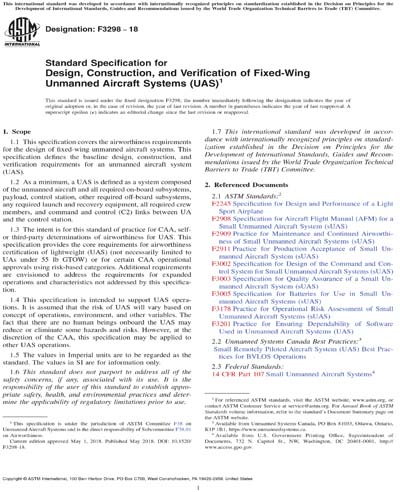Historical
ASTM F3298-18
Standard Specification for Design, Construction, and Verification of Fixed-Wing Unmanned Aircraft Systems (UAS)
1.1 This specification covers the airworthiness requirements for the design of fixed-wing unmanned aircraft systems. This specification defines the baseline design, construction, and verification requirements for an unmanned aircraft system (UAS).
1.2 As a minimum, a UAS is defined as a system composed of the unmanned aircraft and all required on-board subsystems, payload, control station, other required off-board subsystems, any required launch and recovery equipment, all required crew members, and command and control (C2) links between UA and the control station.
1.3 The intent is for this standard of practice for CAA, self- or third-party determinations of airworthiness for UAS. This specification provides the core requirements for airworthiness certification of lightweight (UAS) (not necessarily limited to UAs under 55 lb GTOW) or for certain CAA operational approvals using risk-based categories. Additional requirements are envisioned to address the requirements for expanded operations and characteristics not addressed by this specification.
1.4 This specification is intended to support UAS operations. It is assumed that the risk of UAS will vary based on concept of operations, environment, and other variables. The fact that there are no human beings onboard the UAS may reduce or eliminate some hazards and risks. However, at the discretion of the CAA, this specification may be applied to other UAS operations.
1.5 The values in Imperial units are to be regarded as the standard. The values in SI are for information only.
1.6 This standard does not purport to address all of the safety concerns, if any, associated with its use. It is the responsibility of the user of this standard to establish appropriate safety, health, and environmental practices and determine the applicability of regulatory limitations prior to use.
1.7 This international standard was developed in accordance with internationally recognized principles on standardization established in the Decision on Principles for the Development of International Standards, Guides and Recommendations issued by the World Trade Organization Technical Barriers to Trade (TBT) Committee.
Content Provider
ASTM International [astm]






